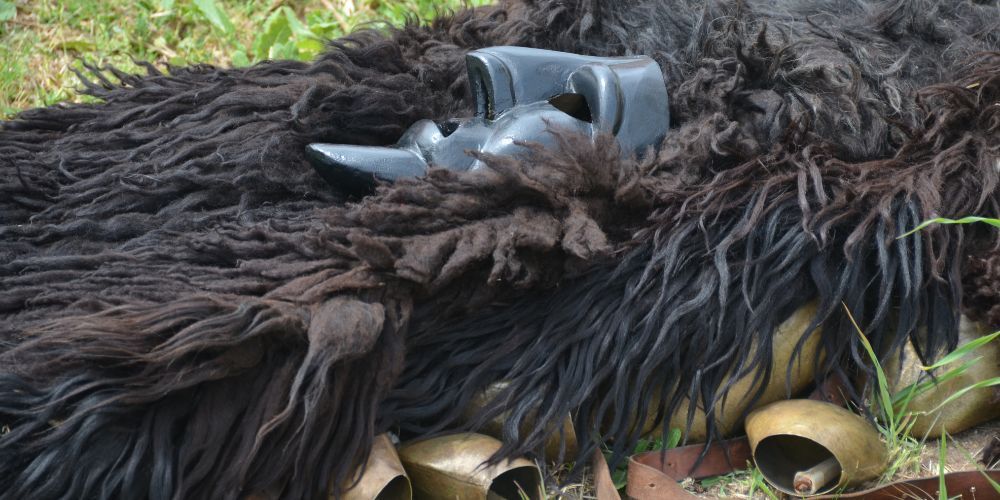The Carnival of Mamoiada in Sardinia is a unique cultural event that recounts the traditions and origins of a people, but it is also a moment of conviviality and unity. There is no shortage of food stands with typical local sweets and cannonau wine in the streets of the village. The traditional event of the Carnival of Mamoiada in Sardinia is among the oldest, becoming famous for the masks of the Mamuthones and Issohadores. Today, it has become a symbol for the entire island. The appearance of the Mamuthones is always a sign of auspicious times and is a ritual that is very much felt and participated in by the entire local population. A strong call of historical tradition and identity that attracts thousands of visitors from the island and around the world every year. A very ancient rite that is deeply felt by the entire local population, who actively participate in the celebration.
The Carnival of Mamoiada in Sardinia officially starts on 17 January with the feast of Sant'Antonio Abate and culminates with the parades on Sunday and Shrove Tuesday. The population participates in the festivities wearing traditional costumes and in the main square of the village they perform the traditional round dance. The festivities are accompanied by the distribution of broad beans with lard, zeppole and plenty of wine. Everything is repeated as a real social ritual, with well-defined rules, characterised by the passage of masks. An orderly and evocative procession is what the visitor is presented with. The square comes to a halt as they pass, everything becomes almost motionless, the only movement is that of the Mamuthones and Issohadores and the only sounds that dominate everything are those of their cowbells. Of course, the Carnival of Mamoiada in Sardinia is not just about masks, it is above all a moment of conviviality and togetherness. Typical sweets and cannonau wine are an integral part of the festival and are offered to the Mamoiadini and all visitors, as the hospitality of this land teaches.

The Carnival of Mamoiada

One of the most celebrated events of Sardinian folklore is certainly the Carnival of Mamoiada. Its most representative masks are the Mamuthones and the Issohadores.
In the Carnival of Mamoiada, the Mamuthones are men with their faces covered by a black mask with rough features, dressed in dark furs and equipped with cowbells hanging from their backs.
While, in the Carnival of Mamoiada, the Issohadores, are men wearing a white mask and a headgear 'sa berritta'. They are dressed in a red bodice, with white trousers 'cartzas o cartzones' and a small feminine shawl 's'issalletu'. The Issohadores are those who, in this kind of procession, escort the Mamuthones. As a sign of good omen for good health and fertility, they catch the young women with laces. In the past, they used to capture landowners to wish them a good year, and the landowners, in return for the honour received, would take the whole group to their homes and offer them wine and sweets.
The masks of the Mamuthones and Issohadores make their first appearance on 17 January on the feast of Saint Anthony, and then see them again on Sundays and Tuesdays during the Carnival of Mamoiada. Today, they are also the attraction of many folkloric festivals in other countries on the island and around the world.
Shrove Tuesday with the arrival of the puppet of Juvanne Martis Sero and the traditional favata officially closes the celebrations. Actually, it is the 'pentolaccia', which will take place in the middle of Lent, that represents the last day of the festival.
The Carnival of Mamoiada is very close to those ancient rituals, where drinking wine, being together and sharing festive moments to propitiate an even better year than the past one have always been part of our traditions. If there is an ancient tradition that comes closest to these concepts that mingle the sacred and the profane, this is it.
To travel to this evocative carnival, you could choose a convenient car rental service that allows you to travel at your own pace.
Carnival in Sardinia

Carnival in Sardinia, which in Sardinian is called 'Carrasegare', begins with the feast dedicated to Saint Anthony Abbot, on 17 January. For the occasion, a large fire is lit and in the evening the forehead is sprinkled with his ashes, although the real start is with Candlemas, on 2 February. Usually Carnival in Sardinia is celebrated with typical dances and traditional masks, during the days of Thursday and Shrove Tuesday, and then ends with the pentolaccia. Although on this wonderful island, every weekend is a good time to celebrate.
Carnival in Sardinia has a thousand fascinating faces and we invite you to discover them all. Here are some of them:
- We have the ancient one of the suggestive Barbagia carnivals that evoke mysterious rites, propitiatory dances and a close relationship between man and animal. Made up of characters with their primitive anthropomorphic and zoomorphic masks, dressed in goat skins, orbaceous and cowbells.
- The vibrant one of the carnivals on horseback, such as the one in Oristano, known as 'Sa Sartiglia', during which the horsemen, as a wish for a good harvest, have to thread a metal star while running.
- That of Santulussurgiu, also known as 'Sa Carrela 'e nanti', in which horsemen show their valour, courage and skill, challenging each other in daring races through the town centre.
- Or the irreverent and allegorical one of Tempio Pausania that ends with the trial and burning in the square of the puppet of His Majesty King George.
- Not to be forgotten is the symbolism of the masquerades in Bosa, here the most important day is Shrove Tuesday. When questors with a jacket worn inside out, their faces painted black with soot and with a red cross on their foreheads go from house to house from dawn to dusk. For each visit they perform traditional Sardinian satirical songs and as a reward they receive sausages, cheese, fruit and sweets that they thread onto a spit and then store in a saddlebag.
Carnival in Sardinia is all this, history, traditions, but also much more. To recount it in a few lines would be too reductive as well as a gamble lost at the start, given the multitude of rituals and customs that have always populated this island of ancient customs. Certainly, Carnival in Sardinia represents another way of telling the story of this land. This is a useful opportunity to make its customs known to the world. All this reinforces the testimony of how multifaceted the tradition is, just as multifaceted is its culture.
Take the chance to explore the enchanting thematic park of Sardinia in miniature, its dinosaurs and predators, and to know the culture of its ancient inhabitants with a Visit Italy ticket.
Discover moreThe most famous masks of the Carnival of Mamoiada in Sardinia

The Carnival of Mamoiada in Sardinia is one of the most famous events in Sardinian folklore. The traditional and best-known masks are definitely the Mamuthones and the Issohadores.
Let's discover together how these typical masks are made:
- The Mamuthones, are dressed in sheep skins and wear a black wooden mask with a suffering or impassive expression. On their backs they carry 'sa carriga', several cowbells tied with leather straps, while around their necks they have smaller bells.
- The Issohadores wear a linen shirt, a red jacket and white trousers, carry a women's shawl over their shoulder and have brass and bronze rattles. Some of them also have a white anthropomorphic mask.
The dressing of the Mamuthones is a very heartfelt ritual of this typical festival and is performed by two people. After this, the Mamuthones parade in groups of twelve, representing the months of the year, and are led by the Isshoadores, who instead parade in groups of eight, and dance, performing steps of considerable difficulty that have been taught to them since childhood.
The parade of the Mamuthones and Isshoadores is a solemn ceremony, organised as if it were a procession.
The Mamuthones, arranged in two parallel rows and flanked by the Issohadores, move very slowly curving under the weight of the cowbells. All that is heard is the rhythmic beat of the cowbells, which shakes them and makes them all ring.
The Issohadores, on the other hand, move, because they are lighter, with quicker, more agile steps. Suddenly they throw their rope, 'sa soha', to catch someone in the audience present. To free themselves, the prisoners have to offer them wine to drink.
The masks make their appearance on the feast of Saint Anthony between 16 and 17 January, then on Sunday and Shrove Tuesday. On the last day, one can watch the procession of the Juvanne Martis Sero mask, which is transported on a cart by men who mourn its death by singing sad songs.
Programme and Dates of the Carnival of Mamoiada in Sardinia 2025

Scheduled events and dates of the Carnival of Mamoiada in Sardinia 2025, the only festival not linked to the Catholic liturgy, with obvious social functions, that uses the canons of theatrical fiction. There is no lack of masks, disguises, satire, grotesque mockery, all well mixed together to overturn forms, roles and hierarchies of everyday normality.
It traditionally begins with the feast of the fires of Saint Anthony Abbot, on 17 January 2025, and ends on Ash Wednesday.
The dates of the Carnival of Mamoiada in Sardinia are mainly concentrated between Shrove Thursday (on 27th Febraury) and Shrove Tuesday (on 4th March).
The Mamuthones and Issohadores Parade will take place between 2 - 4 March.
How to get to the Carnival of Mamoiada in Sardinia

Getting to the Carnival of Mamoiada in Sardinia is very easy as it is centrally located with respect to the island's main ports and airports. From the cities of Cagliari, Sassari, Alghero and Olbia, you can go by car or public transport. All you have to do is head for the central region also known as Barbagia, which is only a few minutes' drive from Nuoro, the provincial capital.
Follow the map that will take you straight to the festivities.
Carnival in Sardinia: the most beautiful customs, masks and traditions

The atmosphere of Carnival in Sardinia is different from the cheerful and festive atmosphere elsewhere, because here ancient agro-pastoral and rural rituals are revived, where man and animals are the undisputed protagonists.
No fat laughter is heard and no confetti is thrown. Here, one waits with bated breath for the arrival of the Boes and Merdules in Ottana, the Thurpos in Orotelli, the Mamuthones in Mamoiada. After all, we are on an island rich in history and tradition.
Each carnival town in Sardinia has its own masks and traditions, let us discover them together:
- King George, Ghjolghju Puntogliu, and sa Mannena in Tempio Pausania.
- The faceless knights of Sa Carrela e'Nanti in Santulussurgiu.
- Sos Boes e Sos Merdules of Ottana.
- Su Componidori of Oristano.
- Gioldzi and the Attittadoras of Bosa.
- The Thurpos of Orotelli.
- La Ratantira and Cancioffali from Cagliari.
- Su Bundhu of Orani.
- Mamuthones and Issohadores of Mamoiada.
About the author
Written on 14/12/2023



Simone Spolitu
Do you know the traditions, customs and costumes of the Carnival of Mamoiada in Sardinia? Find out everything there is to know with us.